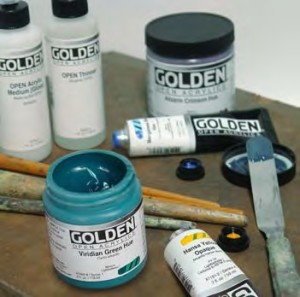 After years of collaboration with our customers and suppliers, our research and development team at GOLDEN is proud to see the fruits of our labor rolled out as a truly innovative new paint system, GOLDEN OPEN Acrylics. GOLDEN OPEN represents the culmination of years of our chemists’ lives, thinking, brewing and partnering to determine how to make water not evaporate so quickly, or more aptly, how to allow the artist to have the level of control over drying they have expressed the need for. We recognize that the fast drying acrylic media, including almost all of our previous offerings on the market, created an entirely new method of working for artists. This allowed for many techniques where quick drying was a dramatic advantage. We also value the other end of the drying spectrum as represented by traditional oil paints. Yet concerns with solvents, too slow drying, and too many rules of how to best insure the artwork will last, result in other problems for many artists. With the introduction of OPEN, there is now a paint system that fills the gap, utilizing the best properties of both. The slow drying of OPEN begins with slowing the evaporation of water and solvents from the paint, such that a relatively thin film can give even an hour of wet time (dependent on temperature and humidity). The extended working time goes beyond simply drying more slowly, and includes a period of time in which it is also reworkable. That is, in the early stages of drying, the film remains sufficiently water sensitive to allow water to readily work back into the paint, almost as though it had never dried. With time, this water sensitivity dissipates, and a strong, resistant film results. The working characteristics of OPEN simply cannot be duplicated by blending retarders or additives in conventional acrylics.
After years of collaboration with our customers and suppliers, our research and development team at GOLDEN is proud to see the fruits of our labor rolled out as a truly innovative new paint system, GOLDEN OPEN Acrylics. GOLDEN OPEN represents the culmination of years of our chemists’ lives, thinking, brewing and partnering to determine how to make water not evaporate so quickly, or more aptly, how to allow the artist to have the level of control over drying they have expressed the need for. We recognize that the fast drying acrylic media, including almost all of our previous offerings on the market, created an entirely new method of working for artists. This allowed for many techniques where quick drying was a dramatic advantage. We also value the other end of the drying spectrum as represented by traditional oil paints. Yet concerns with solvents, too slow drying, and too many rules of how to best insure the artwork will last, result in other problems for many artists. With the introduction of OPEN, there is now a paint system that fills the gap, utilizing the best properties of both. The slow drying of OPEN begins with slowing the evaporation of water and solvents from the paint, such that a relatively thin film can give even an hour of wet time (dependent on temperature and humidity). The extended working time goes beyond simply drying more slowly, and includes a period of time in which it is also reworkable. That is, in the early stages of drying, the film remains sufficiently water sensitive to allow water to readily work back into the paint, almost as though it had never dried. With time, this water sensitivity dissipates, and a strong, resistant film results. The working characteristics of OPEN simply cannot be duplicated by blending retarders or additives in conventional acrylics.
OPEN will appeal to a broad range of painters for whom the fast drying nature that acrylics are generally known for, is not a benefit. Where time for blending and shading is critical, including portraiture and plein air painting, OPEN will work nicely. OPEN also holds potential for various printing techniques, especially monoprinting and screenprinting, in which paint drying on the tools is a key limiting factor. Any artist trying to achieve greater softening, detail or blending will also find that OPEN is ideal.
Not only does the slow drying of OPEN yield uniquely relaxed working characteristics, but also a remarkable ability to stay wet on a palette. A thick dollop of OPEN can stay wet not just for an hour or so, but potentially for days. Color blending on the palette becomes much less stressful, as artists cannot only take their time in creating the ideal shade, but also in using the blend without fear of it drying out. All this adds up to much less wasted paint. Paint sitting on the palette at the end of the day can readily be recovered and put back in the container, as virtually none will be lost or stuck to the palette. Additionally, brushes can be cleaned up later during a painting session without the fear of the acrylic gluing all the expensive natural hair bristles together.
While oils give considerably more working time, OPEN offers balance and simplicity. There are so many technical restrictions with oils; avoiding lean over fat, allowing six months drying before varnishing, and issues with acids leaching into supports. With OPEN, there is generally one rule – relax. I know this sounds strange to any acrylic painter, yet the extended working time will take a good deal of the stress out of the process, and allow artists to focus more on the end result.
GOLDEN OPEN as a water-based paint is impacted by the conditions of the local atmosphere (temperature, humidity and air flow). These factors can dramatically impact the evaporation rate of water. That said, even in drafty, warm and dry conditions, the advantages of OPEN will be seen and felt. The absorbency of the substrate is another given factor, and again, even on very absorbent surfaces, the enhanced working time of OPEN will be appreciated. Working in more humid conditions and using a nonporous palette or substrate will greatly expand the wet, open time of the paint.
There is maybe one guideline to always keep in mind, which, like the atmosphere and substrate is quite straight forward, and that is to paint relatively thinly. The advantage of OPEN is slow drying, which will be most noticeable in thin films, where conventional acrylics would dry quickly. In thick impasto applications, any acrylic dries relatively slowly, giving time to manipulate. In addition, when OPEN is applied in such thick areas, the slow drying can be a curse, as the paint stays mobile and tacky for what may seem like forever. Thus for OPEN, keep it thin, and use conventional acrylics for thick passages. After all, to benefit from the relaxed qualities or work when utilizing OPEN, no need to add stress and wonder when the thick areas will dry. During my 20 year history of making artist paints, it is inevitable that as soon as we proscribe how to use these paints, artists will go in the opposite direction. So let me share now, that the paints will dry in thick areas, yet depending upon the conditions, it could be months before they begin (yes, begin) to dry. I am also confident that painting thick could create other problems and unique stresses on the painting surface. I am sure, however, that someone will discover how to take aesthetic advantage of that as well.
History of development
I wish I could brag about how this grand discovery was made in a flash, waking up from a dream and taking notes, a thought in the shower, etc. Instead, this has been the result of many, many years of work trying to determine how to extend the working time of paint while giving the artist the tools and control they need. We have tested hundreds of unique new raw materials, in thousands of formulations, before finding a path toward fulfilling the need for significant working time without major shortcomings.
One of the most obvious paths toward creating the desired extended working time and properties is to work in a soluble system. This approach allows for the wet product on the brush to constantly bite or re-dissolve the dry or partially dry film, thus allowing for blending as though the film never set to begin with. One downside, of course, is the wet paint will always re-wet the film, causing blending, even when this is not sought after. Another concern is how to protect the artwork for storage, shipping and display, as the risk of solvent contact changing the artwork is significant. Watercolors are an example of a resoluble system, and the requirement to display behind glass for protection is often not desirable.
Another seemingly obvious path toward extended working time is to utilize oils. After all, oils are well known for slow drying, allowing for extensive blending. We know oils have numerous concerns as well – from simply being too slow drying, to a range of technical restrictions, to the well known concerns regarding embrittlement and yellowing. Considering oils may dry too slow for some artists, the next area to investigate would be alkyds, which are oils modified to dry more quickly. We have investigated many alkyds, including water-reducible versions, but the reality is that there is a big difference between drying time and working time. Alkyds do dry fairly slowly, but they do not have great open or working time, as they tend to tack up quickly, becoming unworkable, just sticky. The very long strap down time (to develop sufficient film integrity to work over) is another concern with alkyds, and while driers help, they also work to further shorten working time. Another possibility would be to investigate the use of humectants.
Humectants are chemicals that are hygroscopic substances, absorbing water from the air. Such chemicals are used in desiccation, as an additive to keep food moist, and similarly in cosmetic products where moisturization is desired. Humectants used in paint formulations are called wet edge extenders, as they can in fact, retard the drying process of the paint by slowing the loss of water as well as evaporating very slowly themselves. Glycerin and sorbitol are very common humectants used in processing. However, these prove not terribly useful in paints, as they are essentially non-volatile, remaining in the paint after drying, where they typically impart some non-desirable properties such as tackiness and/or water sensitivity. They tend to create more tack than actual working time.
The glycols are another large group of chemicals that are used as humectants and/or wet edge extenders – from ethylene glycol (effective but toxic), to propylene glycol, to poly glycols. They can all be effective at slowing the drying of the paint, and thus getting more working time, however, they also tend to remain either permanently in the paint film, or simply for too long a period to achieve reasonable film integrity.
Unique problems for this type of open time
It is now probably obvious, while the goals of creating slower drying and more working time are laudable, they come not without concern regarding the integrity of the paint. A natural concern for a water-based binder that is being made to remain open longer, and cure more slowly, would be that there is some level of increased water sensitivity. After all, to slow the drying, one must slow the loss of water. Also by slowing the curing process, the development of some important final film properties are delayed, namely water and solvent resistance.
Another concern that can result from the use of wet edge extenders or humectants is the softness they impart in the film, which can often remain for a period of time, and in some cases, forever. Such materials also cause hydroplasticization, which is a further softening of the film as the result of water not being allowed to leave, or being absorbed back into the paint film.
Since the binder, or polymer, is the portion responsible for film formation, and thus drying, it may seem that a reasonable approach to slow drying would be to remove some of the binder. While this certainly can give more working time, it is generally not without the risk of loss of film integrity, and significant water and/or chemical sensitivities.
Needless to say, overcoming these limitations and achieving the ultimate goal of extended working time has proven challenging. Only after extensive research, way too many trials, and probably some luck, did we realize a series of discoveries that coupled together, yielded the desired outcome. Another factor was that we finally accepted the key realization that we did not have to create the perfect solution and still, the results could be incredibly special.

Balancing the formula
One of the most important components of this innovative paint system is of course, a new binder. We investigated numerous chemistries, from acrylics and alkyds to urethanes and vinyls. In the end, we found that the tried and true, 100% acrylic, bringing with it good durability, safety, good UV resistance, low color, good water, solvent and alkali resistance, happened to also maximize the sought-after working properties.
Typical acrylic binders formulated with such high levels of humectants to maintain extended open time result in excessive water sensitivities. OPEN required a unique acrylic binder with a customized balance of properties, which leads to excellent water resistance and tight film formation, while being very stable in water. A carefully balanced stabilization package leads to a minimum level of surfactants, which are required for shelf stability and to assist in making the binder and pigment compatible, thus reducing potential for water sensitivity. Another key attribute of this binder is that the polymer morphology has been optimized for film formation, yielding tighter, less water sensitive films. Finally, the polymer has high molecular weight coupled with optimized and balanced monomer selection, insuring good film formation and flexibility, while retaining as much hardness as possible.
The next critical group of raw materials for a paint that has maximized working time would be the humectants, or wet edge extenders. As mentioned previously, there are many considerations involved when working with them. Toxicity of the material is always a factor when formulating paints. A few wet edge extenders that have been used historically in paints which were later realized to be quite toxic are ethylene glycol and diethylene glycol, thus we have avoided the use of these materials. Another critical factor is the evaporation rate of the material. While the goal of maximizing working time would suggest that the ideal material would evaporate as slowly as possible, we still require the material to leave the film in a “reasonable” amount of time. If the material were to stay in the film too long, the result would be an excessively tacky film as a result of lowering the glass transition temperature of the binder, thus softening, as well as hydroplasticization. The final choice for which humectants to use and at what levels was certainly one of the largest challenges in the balancing act that resulted in this unique new formulation. In the end, we incorporated very safe materials that serve this function well of yielding the desired extended working time, yet leave the film in a “reasonable” time frame (dependent on many factors, but generally a few weeks).
Strokes through wet drawdown of OPEN Acrylics

Basically, every binder has a limit to the amount of pigment it can hold in a paint film. To form a strong and flexible film, the binder must coat all pigment surfaces, as well as fill all voids
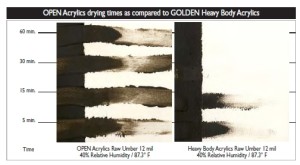
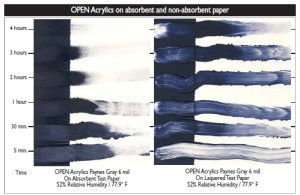
between pigment particles, forming a continuous phase. This results in a critical pigment/binder ratio that must be factored into formulations. Higher levels of pigment above this critical ratio and insufficient binder result in a fragile, matte film. One can imagine that a natural results of the requirement of long working time leads to fairly high levels of wet edge agents/ humectants, diluting the binder level of the paint. This dilution of binder then translates to less capacity to hold pigment in the paint. This led to an additional requirement of the ideal binders we sought in developing this distinctive paint – a binder that allows for a higher level of pigment load than typical binders, hoping we could minimize the dilution effect. Generally, I would say we were successful. Overall pigment load is less than GOLDEN Heavy Body Acrylics, yet the pigment/binder ratio in most cases is actually higher. While we worked hard to maximize pigment load and would have loved to have a paint system with even higher pigment than the current GOLDEN Heavy Body colors, we realized that this trade off was necessary to insure the extended open time and distinct properties of this new paint. After all, a new paint that could not deliver on the strategic quality of significantly increased working time, would be just another paint, and not at all exciting.
Wonderful serendipity
The formulation process was successful in building in the properties we were after. The extended working time is truly exceptional, putting this paint system in its own category, alone in performance, bridging the gap between the wonderful fast drying standard acrylics, and the always important linseed oil based art paints. Whether by design or true serendipity, there are a few working properties regarding the outcome of the technical requirements of the paint that are important to mention. These properties take this paint from being simply a slow drying paint to a system that allows for new possibilities in the way water-based paint can be utilized. This system has some very simple tools and rules, that when understood (NO chemistry degrees required!), will serve the artist well in opening new possibilities of expression.
First, this paint system is water-based. Water itself is, of course, an important additive. Not only can water be used for plays a key role in being able to extend the working time for further blending. While the film is in its early stages of forming, or setting up, water can also serve to re-wet or re-open the film. This restores the paint to a workable state for further manipulation and blending, which is truly unique as it results in pushing thin films of paint around for an hour or more. The standard fast drying acrylics do not have such a quality, as they may only be re-wet for a few minutes and even then,
tend to tear and resist re-wetting once drying begins.
Another truly exciting property or characteristic is what we call the “sweet spot”. That is, as the paint dries and loses some initial water, it thickens, forming a stiffer, more oil-like feel. While initially the OPEN
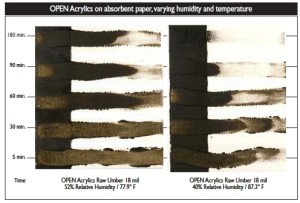
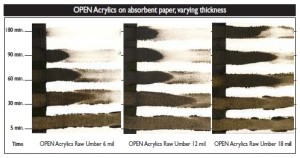
product is rather slick and greasy feeling under the brush, as the water evaporates, it transforms into this wonderfully thick paint, where the “sweet spot” yields a much firmer feel, more oil-like. During development testing, working with various artist panels, this was almost always mentioned as the favorite product attribute. Making an acrylic feel like an oil, and move and blend like an oil, was no small feat.
Every paint line needs its mediums or extenders for the individual to be able to adjust and fine tune to their requirements. The OPEN Acrylic Gel (Gloss) was developed to allow the artist to maintain the same working properties and consistency of the OPEN paint, for purposes of increasing translucency. This can be important when layering colors, for glazing or simply for economics and making the paint go further. The OPEN Acrylic Medium (Gloss) is similar in composition to the Gel, simply thinner. This will allow for reducing viscosity of the paint for increased flow, while maintaining the same working time. Finally, the OPEN Thinner is unique in that it contains no binders, and is more of a “solvent” for the OPEN Acrylics. This Thinner is important for palette management to effectively replace the water and humectants lost from the paint as they remain open to the atmosphere on the palette. The Thinner can also be used to extend the working time in thin films by re-opening films that have started to dry, allowing for further working and blending.
Continued testing and evaluation
 We understand that this is like no other acrylic, but also like no oil, and is certainly NOT to be considered an alternative to either. Its properties set it apart and therefore, its uses should as well. We will continue to test and push OPEN Acrylics to its limits to be sure we fully understand its strengths and weaknesses, including its use for exterior applications.
We understand that this is like no other acrylic, but also like no oil, and is certainly NOT to be considered an alternative to either. Its properties set it apart and therefore, its uses should as well. We will continue to test and push OPEN Acrylics to its limits to be sure we fully understand its strengths and weaknesses, including its use for exterior applications.
As a company, we have worked diligently in pursuing research and collaboration within the museum and industrial sciences to demonstrate that acrylics are in fact, the most versatile and permanent materials available to working artists. With the introduction of OPEN Acrylics, we believe we have extended that range now to the most complete system for any artist working in paint.
While this product is an acrylic paint, it really feels like no other paint. The distinctive performance features of OPEN Acrylics are built into the product. Without the need to modify their paints with an extensive array of retarders, mediums and additives, or to race to finish their work before the paint dries, artists are brought closer to their work. If an artist does desire to modify opacity or speed up drying time, OPEN Acrylics are designed to be a seamless extension of the existing GOLDEN line of acrylics and mediums and may be blended with them to achieve the desired result.
OPEN Acrylics represent a significant advancement to the most comprehensive suite of professional acrylics available.We are confident that OPEN Acrylics will inspire experimentation, innovative applications and unique possibilities for artists already familiar with what acrylics can do for their work and generate interest from artists just starting to explore this type of medium.
About Jim Hayes
View all posts by Jim Hayes -->Subscribe
Subscribe to the newsletter today!
No related Post

